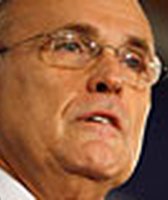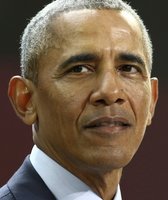Stand up for the facts!
Our only agenda is to publish the truth so you can be an informed participant in democracy.
We need your help.
I would like to contribute
SUMMARY: Rudy Giuliani makes a case that the United States lags behind foreign nations when it comes to energy infrastructure. But he overstates the foreign energy juggernaut and ignores enormous energy investments at home.
"Energy independence" has caught on as a byword on both ends of the political spectrum. The Democrats tout the environmental benefits, while the GOP focuses on the geopolitical consequences. Rudy Giuliani made his case in a debate Jan. 5, 2008, that America hasn't done enough to achieve energy independence.
"We've talked about it a long time; we just haven't done it," Giuliani said.
We're being outstripped by other countries, he argued, saying, "We haven't built a refinery, I think, in 30 years. We haven't licensed a nuclear power plant in 30 years. France is 80 percent nuclear; we're 20 percent nuclear. China is building 40 nuclear power plants. We're having trouble getting one licensed for the last 30 years."
Giuliani gets most of his numbers correct, but he tells just part of the story.
Let's take it piece by piece:
"We haven't built a refinery, I think, in 30 years."
The last spanking-new refinery built in the United States was the Marathon Oil refinery in Garyville, La., in 1976, said Bill Holbrook, communications director for the National Petrochemical & Refiners Association, an industry trade group.
But that's not the whole story, he said.
"When people say that, they're implying that the industry has done nothing to increase capacity," Holbrook complained. "And that is inaccurate."
The industry has found it costs less money and takes less time to expand existing facilities, he said. Over the past 15 years, the U.S. refining industry has added the equivalent of one new, state-of-the-art refinery a year, each with a capacity to refine 150,000 to 300,000 barrels per day.
Jonathan Cogan, senior analyst with the Energy Information Administration, echoed Holbrook: "Not quibbling with the wording, but it leads you to believe we haven't increased our refining capacity. We have."
In fact, the United States has added nearly 1.7-million barrels per day of refining capacity since 1985, according to the administration's records.
Cogan said Garyville is the last "significant" refinery built, and industry experts often think of it as the most recent. But there have been a handful of smaller refineries built since then. However, those can handle only a fraction of Garyville's capacity, according to the EIA, the information arm of the Department of Energy.
"We haven't licensed a nuclear power plant in 30 years."
The last new nuclear plant in the United States to receive a construction license was Shearon Harris in North Carolina in January 1978, said Mitch Singer, spokesman for the Nuclear Energy Institute.
Like refineries, U.S. nuclear power has expanded. Giuliani fails to note the "uprates" that many of those plants plan or have undergone, which increase their electricity output.
Last year, the Nuclear Regulatory Commission calculated that uprates added 4,183 megawatts of new capacity as of mid 2004, with an additional 947 megawatts under consideration.
That's the rough equivalent of nearly five new plants, explained Roger Hannah, spokesman for the Nuclear Regulatory Commission.
It's also not clear how expanding nuclear would lead to energy independence.
Nearly 84 percent of the uranium used in U.S. nuclear plants comes from foreign countries, mostly Australia, Canada and Russia, said Doug Bonnar, operations research manager for the Energy Information Administration.
"France is 80 percent nuclear; we're 20 percent nuclear."
Giuliani was spot on with the estimates of how much power we get from nuclear power, according to the International Atomic Energy Agency. In 2006, the United States got a smidge more than 19 percent of its power from nukes. France hit 78 percent.
But take a closer look at those IAEA numbers: France has 59 operating power plants; the United States has 104. In 2006, France produced 428,700 gigawatt hours of electricity from nuclear power. The United States produced 787,200 gigawatt hours from its nukes — nearly twice as much.
In fact, the U.S. nuclear fleet produced 43 percent more electricity than all of France's energy sources combined. Then again, the United States uses more than seven times more electricity than France, for a whopping 4,058,085 gigawatt hours in 2006.
"It's not feasible for us to be at 80 percent nuclear. We're a much bigger country," said Singer, of the Nuclear Energy Institute. By his estimate, the United States would need about 400 plants to reach 80 percent nuclear.
"China is building 40 nuclear power plants."
Not so, says the IAEA, which counts just five nuclear power plants under construction in the People's Republic of China.
However, Giuliani's number isn't a complete fairy tale. China has set a goal of having 40,000 megawatts of installed nuclear capacity by 2020, said Singer, of the Nuclear Energy Institute.
The country already has 11 operational plants, with a total gross capacity of 9,078 megawatts, according to the International Atomic Energy Agency. That leaves 34,922 megawatts between China and its nuclear goal. The five plants under construction will have a combined capacity of 4,553 megawatts.
How many plants it will take to make up the remaining 30,369 megawatts depends on the size of the plants, explained Singer. Most of the new plants have a capacity of 1,100 megawatts or more, which would take nearly 28 plants, but it could be more if the plants are smaller.
Add the five under construction, and you could get within striking distance of Giuliani's "40." But only if China's aspirations count as "building." If aspirations count, then the United States is "building" the 30 or so new nuclear plants for which plans have been announced.
"We're having trouble getting one licensed for the last 30 years."
True, the United States hasn't licensed construction of a new plant in 30 years.
Late last year, four power producers began the application process with the Nuclear Regulatory Commission, said Hannah. That process is expected to take about three years.
Now, Giuliani prefaced his whole statement by saying, "We really have to take the idea of energy independence and turn it into a program for energy independence." He cites numbers that are mostly accurate, but he's missing context that might affect his ideas of energy independence.
UPDATE: The last new refinery of significant size built in the United States was a Marathon Oil refinery in Garyville, La. Previously, we reported an incorrect name for the facility.
Our Sources
International Atomic Energy Agency, Latest news related to PRIS and the status of nuclear power plants, 2007 highlights
Nuclear Regulatory Commission, Fact sheet on power uprates for nuclear plants,
Nuclear Regulatory Commission, Operating Nuclear Power Reactors by Location or Name, Harris 1
Energy Information Administration, U.S. Operable Crude Oil Distillation Capacity, updated Dec. 21, 2007
Interview with Jonathan Cogan, senior analyst, Energy Information Administration, Jan. 7, 2008
Interview with Bill Holbrook, director of communications, the National Petrochemical & Refiners Association, Jan. 7, 2008
Interview with Roger Hannah, spokesman, Nuclear Regulatory Commission, Jan. 7, 2008
Interview with Mitch Singer, spokesman for the Nuclear Energy Institute, Jan. 7, 2008





























